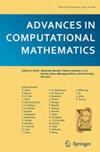A stochastic perturbation analysis of the QR decomposition and its applications
Abstract
The perturbation of the QR decompostion is analyzed from the probalistic point of view. The perturbation error is approximated by a first-order perturbation expansion with high probability where the perturbation is assumed to be random. Different from the previous normwise perturbation bounds using the Frobenius norm, our techniques are used to develop the spectral norm, as well as the entry-wise perturbation bounds for the stochastic perturbation of the QR decomposition. The statistics tends to be tighter (in the sense of the expectation) and more realistic than the classical worst-case perturbation bounds. The novel perturbation bounds are applicable to a wide range of problems in statistics and communications. In this paper, we consider the perturbation bound of the leverage scores under the Gaussian perturbation, the probability guarantees and the error bounds of the low rank matrix recovery, and the upper bound of the errors of the tensor CUR-type decomposition. We also apply our perturbation bounds to improve the robust design of the Tomlinson-Harashima precoding in the Multiple-Input Multiple-Output (MIMO) system.

 求助内容:
求助内容: 应助结果提醒方式:
应助结果提醒方式:


